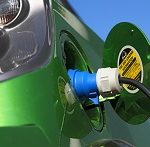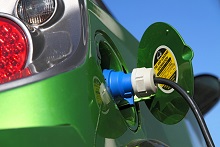Internet2 will provide electric vehicles to universities experimenting with the Internet of Things
 The nonprofit computer networking consortium Internet2 will provide electric vehicles to four colleges and universities to be used in research of the Internet of Things.
The nonprofit computer networking consortium Internet2 will provide electric vehicles to four colleges and universities to be used in research of the Internet of Things.
The type of vehicle, unveiled this week at the Internet2 Global Summit in Denver, was created by Innova Inc. Based on European micro-car technology, the small car is called the Innova Dash and can move up to 35 mph. It can go about 100 miles before needing recharged.
“Our goals are for campuses to use this electric vehicle to enhance sustainability research involving data collection and data transfer across campus networks, and to adopt advanced identity management technologies,” said Steve Wolff, Internet2 chief technology officer. “At the same time, the vehicles will demonstrate a low-carbon-footprint campus transportation alternative.”
A mobile app will let users know when a vehicle is available. The vehicles can be accessed by using campus identification to log in, reserve, and activate them.
Inside the vehicle, drivers will find tablet-sized computers that can control the vehicle’s electronics. The vehicle can connect to campus wifi networks, allowing it to communicate with a university’s computer network.
It’s that communication that allows the cars to be used in Internet of Things research.
(Next page: What is the Internet of Things?)
The Internet of Things is a network of physical, everyday objects that use embedded technologies to interact with each other. Think how a tablet communicates with a laptop or smartphone, sharing information and reacting to prompts.
Now imagine a similar interaction between an alarm clock and a smart car. Or between two cars driving on the highway.
“This will lead to improved safety, security, and loss prevention in the insurance industry,” research firm Gartner said last year. “Internet of Things will also facilitate new business models, such as usage-based insurance calculated based on real-time driving data. The banking and securities industry will continue to innovate around mobile and micropayment technology using convenient point-of-sale terminals and will invest in improved physical security systems.”
Gartner predicted that there will be more than 26 billion items on the Internet of Things by 2020, an number far greater than the 7 billion smartphones, tablets, and computers predicted to be around.
Internet2 and Innova said they hope the advanced electric vehicles can help researchers better understand the quickly growing network. At the end of the project, all of the data will be publicly available to researchers.
“The project is part of Innova’s goal of engaging with researchers in all fields across higher education.University involvement gives campus participants an ideal dense use environment in a contained space,” said Roman Kuropas, Innova’s chief executive officer. “I am excited about discovering new applications to leverage the vehicle, the Internet2 Network and services to benefit campuses nationwide.”
Interested universities can apply to be apart of the project by visiting Internet2’s website, which proclaims that the experiment will “help move beyond ‘bring your own device’ (BYOD) to devices that can bring you!”
Follow Jake New on Twitter at @eCN_Jake.
- What does higher-ed look like in 2023? - January 5, 2015
- Are ed-tech startups a bubble that’s ready to burst? - January 1, 2015
- Are MOOCs really dead? - August 28, 2014

